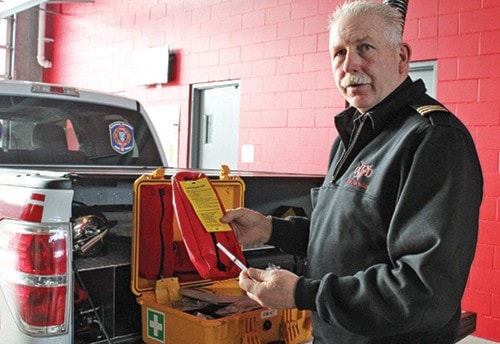Firefighters in the three municipalities on the Saanich Peninsula have been undergoing training to administer an overdose remedy known as Naloxone.
“I think for us, it’s just another tool in our tool kit. For us, when we go to calls, it just helps us deliver a higher level of service to the public and helps people that need it,” said Forrest Owens, assistant chief and training officer for the Central Saanich Fire Department, who underwent training in December.
The training is an addition to the first responder curriculum that allows the crew to perform inter-muscular injections and more in-depth training to recognize the signs and symptoms of an opioid or narcotic overdose.
“We have attended a number of overdose calls. We have not yet administered Naloxone, but that doesn’t mean that we wouldn’t,” said Sidney Fire Chief Brett Mikkelsen.
The Sidney Fire Department has been Naloxone-certified for approximately a month.
“It’s a new reality, it’s definitely something that we’re going to have to deal with … and if it’s something that we can provide that assists the public, ultimately that’s our job,” said Mikkelsen.
As for the North Saanich Fire Department, everyone will be trained this month.
“You can’t ignore that it’s happening,” said North Saanich Fire Chief John Trelford. “North Saanich is pretty rural and it’s pretty sheltered from that kind of activity, however we’ve got an international airport and a major ferry terminal within our district.”
Trelford added it’s not just the residents of the district, but visitors as well.
The training, which takes about three hours, covers a practical instruction and overview of the drug and its function.
Owens said the Central Saanich fire department also does the procedure for their own protection, as they too could be exposed to some of the toxic material.
“If you touch it and it absorbs through your skin, you can get affected,” he said, adding that police officers and ambulance workers have had that happen before.
The procedure uses a syringe with a vial of Nalaxone, injected into the arm or thigh of an individual.
“It’s usually about five minutes for them to respond,” said Owens.
If somebody isn’t breathing, he said, the firefighters’ main priority is to breathe for them, so they’ll bag-valve mask them while someone prepares the injection.
Owen said they attended one overdose incident where the individuals involved injected themselves.
Some places, like dispensaries, he said, will give individuals a Narcan kit (a Naloxone brand name).
Owens said it’s not always a person who takes drugs that can be injected.
“We have a lot of palliative care people, and if you take high doses of morphine, that’s an opiate. So somebody that’s in palliative care could also take enough morphine that it could suppress their breathing,” said Owens.
